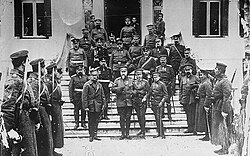
Back اغتيال الأرشيدوق النمساوي فرانتس فرديناند Arabic Atentáu de Sarayevu AST Sarayevo qətli Azerbaijani Сараеўскае забойства Byelorussian Сараеўскае забойства BE-X-OLD Сараевски атентат Bulgarian আর্চডিউক ফ্রাঞ্জ ফার্দিনান্দের গুপ্তহত্যা Bengali/Bangla Gwalldaol Sarajevo Breton Sarajevski atentat BS Assassinat de Sarajevo Catalan
 Assassination illustrated in the Italian newspaper La Domenica del Corriere, 12 July 1914 by Achille Beltrame | |||||
| Date | 28 June 1914 | ||||
|---|---|---|---|---|---|
| Location | Near the Latin Bridge, Sarajevo, in the Condominium of Bosnia and Herzegovina, Austria-Hungary | ||||
| Coordinates | 43°51′28.5″N 18°25′43.9″E / 43.857917°N 18.428861°E | ||||
| Deaths | Archduke Franz Ferdinand and his wife, Sophie | ||||
| Convicted | Gavrilo Princip and others... | ||||
| Charges | High treason | ||||
| Sentence | 20 years | ||||
| Weapon | FN 1910 semi-automatic handgun | ||||
| |||||
| Events leading to World War I |
|---|
 |
|
The assassination of Archduke Franz Ferdinand[a] was one of the key events that led to World War I. Archduke Franz Ferdinand of Austria, heir presumptive to the Austro-Hungarian throne, and his wife, Sophie, Duchess of Hohenberg, were assassinated on 28 June 1914 by Bosnian Serb student Gavrilo Princip. They were shot at close range while being driven through Sarajevo, the provincial capital of Bosnia-Herzegovina, formally annexed by Austria-Hungary in 1908.
Princip was part of a group of six Bosnian assassins together with Muhamed Mehmedbašić, Vaso Čubrilović, Nedeljko Čabrinović, Cvjetko Popović and Trifko Grabež coordinated by Danilo Ilić; all but one were Bosnian Serbs and members of a student revolutionary group that later became known as Young Bosnia. The political objective of the assassination was to free Bosnia and Herzegovina of Austria-Hungarian rule and establish a common South Slav ("Yugoslav") state. The assassination precipitated the July Crisis which led to Austria-Hungary declaring war on Serbia and the start of World War I.
The assassination team was helped by the Black Hand[citation needed] , a Serbian secret nationalist group; support came from Dragutin Dimitrijević, chief of the military intelligence section of the Serbian general staff, as well as from Major Vojislav Tankosić and Rade Malobabić, a Serbian intelligence agent.[citation needed] Tankosić provided bombs and pistols to the assassins and trained them in their use. The assassins were given access to the same clandestine network of safe-houses and agents that Malobabić used for the infiltration of weapons and operatives into Austria-Hungary.[citation needed]
The assassins and key members of the clandestine network were tried in Sarajevo in October 1914. In total twenty-five people were indicted. All six assassins, except Mehmedbašić, were under twenty at the time of the assassination; while the group was dominated by Bosnian Serbs, four of the indictees were Bosnian Croats, and all of them were Austro-Hungarian citizens, none from Serbia. Princip was found guilty of murder and high treason; too young to be executed, he was sentenced to twenty years in jail, while the four other attackers also received jail terms. Five of the older prisoners were sentenced to be hanged.
Black Hand members were arrested and tried before a Serbian court in Salonika in 1917 on fabricated charges of high treason; the Black Hand was disbanded and three of its leaders were executed. Much of what is known about the assassinations comes from these two trials and related records. Princip's legacy was re-evaluated following the breakup of Yugoslavia, and public opinion of him in the successor states is largely divided along ethnic lines.
Cite error: There are <ref group=lower-alpha> tags or {{efn}} templates on this page, but the references will not show without a {{reflist|group=lower-alpha}} template or {{notelist}} template (see the help page).
© MMXXIII Rich X Search. We shall prevail. All rights reserved. Rich X Search
